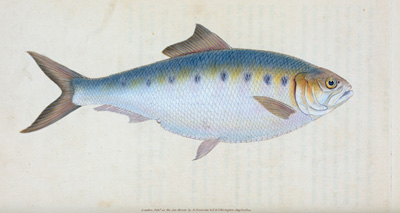

• Intro / Home
• Historical Neighbors
• Street and Backyard
Neighbors
• Park and Green Places
Neighbors
• Shore and Wetlands
Neighbors
• Salt and Freshwater
Neighbors
• Tiny Neighbors
• Unwelcome Neighbors
• Occasional and
Unexpected Neighbors
•
Wildlife Sighting Log
• Resources
• Hours and Tours
• Press Release
• NYPL HOME
| Salt and Freshwater Neighbors | |
The American Shad, a large member of the herring family, is an abundant and valuable commercial fish of the New York region, prized not only for the female’s eggs, or roe, but also for the delicious flesh. Those found in the Hudson River average 20–23 inches long, and weigh 5 to 6 pounds. Shad are anadromous, meaning that they spend most of their life in salt water, but spawn upstream in fresh water in the river where they hatched. Unlike Pacific salmon, who die after spawning, many Shad return to the ocean, to breed again in the Hudson in subsequent years. The hatchlings swim downstream in the fall, and grow to maturity in the ocean. Edward Donovan’s (1768–1837) enormous collection of natural history specimens provided many of the models for the animal portraits in his books on fishes, insects, and birds.
|
